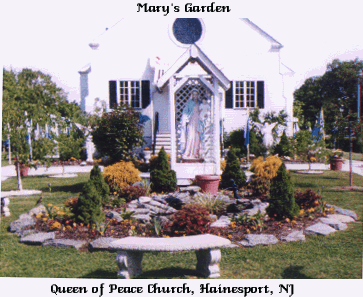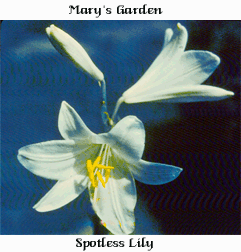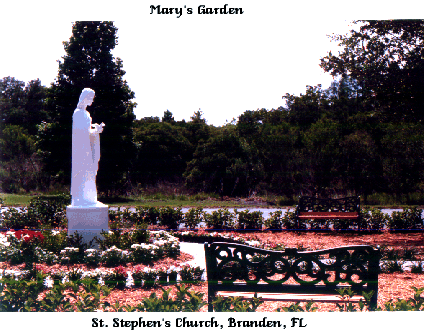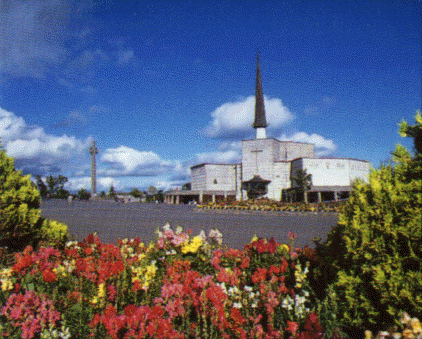John Stokes and Mary's Gardens
Spirituality of Parish and Shrine Gardens
Parish and Shrine Mary Gardens
– John S. Stokes Jr.
Parish and shrine Mary Gardens differ from private home Mary Gardens in respect to their public character, their mode of incorporation in devotional life, and the arrangements for their stewardship.
Public Character
As distinct from conventional institutional landscaping and architectural statuary placed in front of a church, the parish Mary Garden of symbolic flowers planted around a focal statue of Our Lady makes a public affirmation of Marian doctrine and devotion to visitors and passers by, expressive of the Church's mission to the community and the world.
Of special significance for our era is the ancient flower symbolism of Mary's divinely endowed privileges and prerogatives - freely accepted and embraced by her in her immaculate purity, humility, fidelity and love - for the mediation and distribution to the world of the graces of sanctification, inspiration, guidance, repentance and reconciliation needed for the building of God's Peaceable Kingdom on earth as it is in heaven.
In our devotion to Mary in church before her altar or participating in her feastday masses, in our praying of the Rosary, and in our group praying of her litanies and novenas and the singing of her hymns in her sodalities and guilds, we privately venerate and praise Mary as the worthy Mother of God, prayerfully beseeching her merciful intercession for our needs. In the Mary Garden, this devotion is brought outdoors in public view.

In the Mary Garden, our custom of meditating on Mary's Mysteries as we pray the Rosary - "that we may imitate what they contain, and obtain what they promise" - is extended through our quickening by her flower symbols to more specific reflection on, and prayerful recourse to, her divinely endowed privileges and prerogatives of: Immaculate Conception, Divine Motherhood, Perpetual Virginity, Co-Redemption, Assumption soul and body into Heaven, Queenship of Heaven and Earth; and Spiritual Motherhood, protection, advocacy and intercession, and mediation and distribution of spiritual grace, light, wisdom and power for the faithful.

In this we rejoice that Mary, full of grace, through her "intimate union and unique cooperation with Christ" (Vatican II Decree on the Apostolate of the Laity, 4), sublimely exemplifies, for our emulation, her and our potential for fulfilling God's purpose for Creation of showing forth and sharing to the fullest, in love, the divine goodness and action with humans, created to this end in the divine image and likeness.
As we turn in prayer to Mary as God's chosen, freely assenting and faithful channel for the distribution to the world of the graces needed for the furthering of God's Kingdom, we are awed by the realization that with her every mediation of grace to us, God's creational desire for the fullest sharing of the divine goodness and action with humans is ever more perfectly accomplished - in Mary and in us.
This Marian message of the Church to the world is spread further each time the flower symbols of Mary's privileges, virtues and prerogatives are reflected on or explained to visitors in the Mary Garden: the white lily symbolizing her purity; the red rose, her love; the hidden violet, her humility; eardrops honoring her hearing of the word of God and keeping it; Our Lady-in-the- shade of her overshadowing by the Holy Spirit; and the up-facing tulip of openness to divine filling.
Likewise, the marigold symbolizes the golden resplendence of the fullness of grace in Mary's soul; the ladyslipper the beauteous footsteps of her obedience; the white-spotted milkdrops her Divine Motherhood of Jesus the God-Man; the strawberry - still in flower while in fruit - her Perpetual Virginity; and the pointed iris spears the co-redemptive Sword of Sorrow piercing her soul as she stood at the foot of the Cross, shedding "Our Lady's Tears".

Also, mid-August-blooming Assumption Lily; the heart-shaped leaves, buds and flowers symbolizing both the interceding Immaculate Heart of Mary and of the merciful Sacred Heart of Jesus; Mary's Eyes of mercy; her Hand of Pity; her flower Keys to the heavenly storehouses of grace; Our Lady's Mantle of spiritual protection, the constancy of "Mother Love" blooms; the Crown of her queenship . . . and other Flowers of Our Lady blooming through the year according to the "Mary Calendar".
The parish Mary Garden as public statement of faith has its origins with the first U.S.. public Mary Garden - founded in 1932 at St. Joseph's Parish in Woods Hole, Massachusetts - which, together with the ringing of the chimes of the Angelus Tower by which it was planted, and with the library of Christian classics in the scriptorium room in the base of the tower, was intended by Mrs. Lillie, its donor, "to remind the scientists who study at the Marine Biological Laboratory across the inlet that there is another and valid aspect of life."
Incorporation in Parish Devotional Life
When the planting of a Mary Garden is first proposed for a parish - by the pastor or by home Mary-Gardeners desiring to share their garden devotion to Mary with the parish - a primary consideration is the formation of a group of parishioners of devotional commitment to Mary, who wish to express this devotion through faithful stewardship for her Garden.
In the simplest terms, those committing themselves to the devotion and work of the Mary Garden are those who:
- Are devoted to Mary
- Wish to express this devotion by tending her flowers in a Mary Garden
- See the placing of a flower before Mary's garden statue similar to the simple devotional act of lighting a candle for her before her altar in Church
- See the planting and caring for the garden as a prayerful offering of work for spiritual intentions
- Sense the garden as a holy place through the priestly sacramental blessing of its statue and planting; and thus a place of gentleness, sweetness, peace and quiet
- Reflect on Mary's qualities, life, mysteries, privileges and prerogatives as symbolized by her flowers
- Aspire to spiritual growth and perfection by emulating Mary's virtues, likewise symbolized by the flowers, and rooting out distractions, vices and imperfections impeding these qualities
- Sense Mary's presence in the garden through her action as Mediatrix, where spiritual insights, inspiration or love are experienced while working or reflecting in it. (Frances Crane Lillie entitled the visitors' leaflet she wrote for the mother Mary Garden in Woods Hole as "Our Lady In Her Garden.")
- Commune spiritually with Mary, our loving Mother, as they work or visit in the garden - sharing with her their joys, sorrows and needs.
- Share in Mary's queenly desire for, and make prayerful recourse to her in her role as Advocate, Intercessor and Mediatrix for the conversion of the world to faith in her Divine Son and Lord, and to the building of his Peaceable Kingdom, as the culmination of Creation.
- Offer the spiritual merits and graces of their gardening work to Mary for her mediating guidance of them to where most needed by souls and the world in the Communion of Saints - offerings again symbolized by the placing of flowers before her statue Where the love of having a parish Mary Garden has grown in hearts, but there is inadequate gardening experience among parishioners to take on a full garden right away, Mary Garden devotion and stewardship have been introduced to others by the giving of small dish and patio container Mary Gardens for their care.
- Or by giving seeds and instructions for a beginning small Mary Garden of easy-to-grow annual Flowers of Our Lady - in preparation for the subsequent cooperative planting and care of a larger parish Mary Garden.

For general introduction of the Flowers of Our Lady and Mary Gardens to parish members, two introductory slide lectures are available from Mary's Gardens: Slide Lecture #1 (1961) of 50 35mm color slides for conventional slide projector with printed and also tape-recorded narration - available on loan through e-mail request to Mary's Gardens; and Slide Lecture #3 (1997), the slides and text for which can be viewed on this website or downloaded and printed out for computer projector presentation.
Among U.S. parish Mary Gardens of special note, that at St. Mary's Parish in Annapolis Maryland, adjacent to historic Carroll House, was established, with pastoral permission and blessing, through the initiative, commitment and responsibility of a group of gardeners, some with 30 years of prior home Mary-Gardening experience.
At St. Catherine of Siena Parish in Portage, Michigan the large Mary Garden along the entire south side of the church was established through pastoral initiative, with lay participation - the initiative of Fr. Thomas Stanley, S.M., Pastor, who early in his priestly career, in 1953, established the first U.S.. shrine Mary Garden at the Lourdes Shrine in Dayton, Ohio, currently being restored.
The first public U.S.. Mary Garden in Woods Hole, Massachusetts, mentioned above, was established in 1932 by a single individual, Frances Crane Lillie, as a donation to St. Joseph's Church, together with a trust fund for its maintenance through the years, and for that of the Angelus Tower by which it is planted, also donated by her to the church. She personally spent time in the garden, often daily, working with a landscape architect and a renowned nurseryman for six years perfecting the planting of the garden.
While in the Mary Garden, Mrs. Lillie would explain the meanings of Our Lady's Flowers - of which she had learned from English monastery gardens and religious folklore researchers - to visitors, including, when he was in Woods Hole, the Bishop of Fall River, who had dedicated and blessed the tower and garden in a special ceremony, with procession and homily.
All three of these gardens are given a unique devotional quality through especially executed focal sculptures of Our Lady - at Annapolis, Mary of Nazareth, with the child Jesus; at Portage, the Woman with child clothed with the sun of Revelations; and at Woods Hole, Our Lady of the Angelus.
Faithful Stewardship
Essential to the integrity, proportion and clarity of the Mary Garden, showing forth its devotional character, is regular faithful stewardship for its watering, weeding, cultivation, edging, trimming, adjustment of plant positions, and any required plant replacements.
For home Mary Gardens this is fitted in harmoniously with daily tasks and schedules; but for parish Mary Gardens, special planning and commitment are required. As parish groundskeepers usually are professionals not participating in parish devotional life, and are present on the grounds perhaps once a week, responsibility for Mary Garden stewardship requires the commitment of one or more parishioners to daily stewardship visits to the garden.
In some parishes the parishioner or parishioners taking primary initiative or responsibility for the Mary Garden have posted sign-up sheets for volunteers to care for the garden for a week each, under the general direction of the Mary Garden chairperson who works with each the first day. In other parishes, volunteers are asked to sign up for longer periods - for specific responsibilities, such as watering, weeding, cultivating, edging, etc.
However, experience has shown that such arrangements have the serious shortcoming that due to unavoidable illness, emergencies or changes in vacation plans, an important stewardship commitment is sometimes unfulfilled - such as the requirement for watering - so that during a heat wave or dry spell the soil becomes hardened and plants may be irretrievably dried up and lost.
What usually happens after several years is that a small group of committed parishioners emerges to take full responsibility for garden stewardship on a mutually worked out flexible but reliable basis. This may involve, for example, several persons who make stewardship visits to the Mary Garden each day after attending daily Mass; others who visit the garden daily after driving their children to school; and still others who have jobs during the week and spend time in the garden on weekends. Essential to this arrangement is the welcoming or recruitment of new group members to carry on through the years - until the end of the world.

At both Annapolis and Woods Hole, garden bed sprinkler nozzles and underground plastic piping have been installed, with adjustably timed main valves, for automatic early morning watering - with noticeable improvement in plant growth and blooms.
Shrine Mary Gardens
At major Marian Shrines there may not be regular parishioners or societies from which a group of Mary Garden stewards may be formed. However, the shrine size and budget may be such that a full time horticulturalist and staff may be employed, with both gardening competence and the employment motivation of a special devotion to Mary.
This is the situation at the national Shrine of Our Lady of Mary's appearance site in Knock, Co. Mayo, Ireland. Here, after reading in 1982 a review in an Irish Catholic weekly by Mary's Garden Associate, Bro. Sean MacNamara, C.F.C., of a chapter on the Woods Hole Mary Garden in the centennial History of St. Joseph's Church, written by parishioner Jane A. McLaughlin - who also restored the Mary Garden for the centennial (and its golden jubilee) according to its developed, 1937, plan - Knock Shrine Director, Msgr.. James Horan, obtained a copy of the Mary Garden plant list and planting plan from Woods Hole and had Shrine Horticultualist, Anne Hopkins Lavin, design and plant an eight-bed Mary Garden with focal sculpture as a setting for the new Blessed Sacrament Chapel. In consultation with Msgr.. Horan, a revised plan with additional Flowers of Our Lady was designed by Bro. Sean the following year.
From her familiarity thus gained with the Flowers of Our Lady, Anne Lavin envisaged that the entire Shrine grounds could be planted with them as "Our Lady's Meadow", which became a reality in 1991, as described in the Knock Shrine Annual for that year:
"Magic Carpet of Colour"
"If some of us had, over the years, thought of Knock as
a grey colourless place, we would surely have had second
thoughts last summer. Early in the spring, Anne Lavin and
her team of gardeners were busily at work planting and sowing
thousands of bulbs, plants and seedlings. Between them they
created a magic carpet of colour. It was something that must
have been noticed by all pilgrims as several spoke of its
beauty.
"Every available inch of the Shrine grounds was filled
with magnificent blooms: roses, gladioli and delphiniums rose
above swathes of antirrhinums, poppies and petunias - a
magnificent blaze of colour stretching from the Gable almost
as far as the eye could see, and, as it happened, seen mostly
under a blue sunny sky. It was a new and splendid attraction
at Knock, comparable with any formal garden wherever one
might seek it, and a perfect setting for peaceful
meditation."
Knock is thus a model for the planting at other Marian shrines of Mary Gardens and Flowery Meades, where the budget and staff organization permit the employment of full time shrine horticulturalists, with Marian devotion.

Copyright, Mary's Gardens 1999
Photo credits:
Queen of Peace Church - Sara Brumer
St. Joseph's Church - Carolyn O'Boyle
Spotless Lily - John Stokes
Dish Mary Garden - Rosemary McCutchen
St. Stephen's Church - Candace Knapp, sculptor
Knock Shrine - Knock Shrine
The John Stokes and Mary's Garden collection was transferred to the Marian Library in May 2013. In addition to his archives, manuscripts, artwork, and personal library, John S. Stokes also donated his extensive website. It was transferred to the Marian Library in early 2010. This particular entry is archived content original to Stokes' Mary's Gardens website. It is possible that some text, hyperlinks, etc. are outdated.